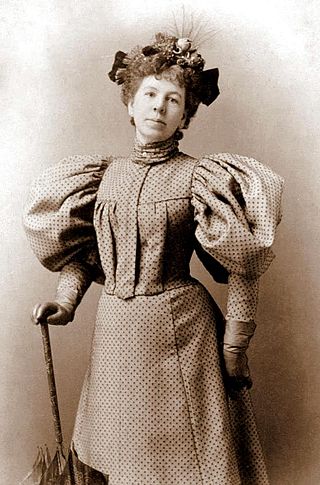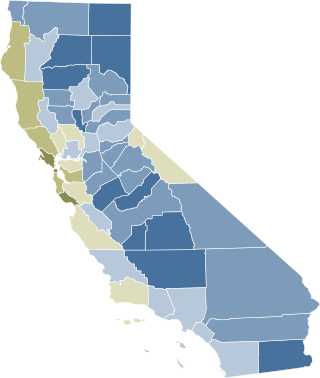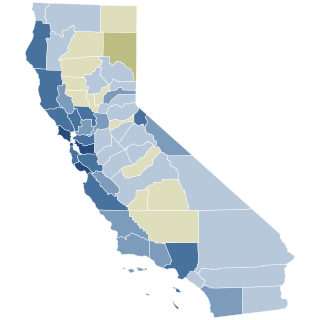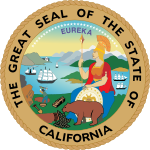
Proposition 209 is a California ballot proposition which, upon approval in November 1996, amended the state constitution to prohibit state governmental institutions from considering race, sex, or ethnicity, specifically in the areas of public employment, public contracting, and public education. Modeled on the Civil Rights Act of 1964, the California Civil Rights Initiative was authored by two California academics, Glynn Custred and Tom Wood. It was the first electoral test of affirmative action policies in North America. It passed with 55% in favor to 45% opposed, thereby banning affirmative action in the state's public sector.
Same-sex marriage has been legal in California since June 28, 2013. The State of California first issued marriage licenses to same-sex couples from June 16, 2008 to November 5, 2008, a period of approximately 4 months and 20 days, as a result of the Supreme Court of California finding in the case of In re Marriage Cases that barring same-sex couples from marriage violated the Constitution of California. The issuance of such licenses was halted from November 5, 2008 through June 27, 2013 due to the passage of Proposition 8—a state constitutional amendment barring same-sex marriages. The granting of same-sex marriages recommenced following the U.S. Supreme Court's decision in Hollingsworth v. Perry, which restored the effect of a federal district court ruling that overturned Proposition 8 as unconstitutional.

California Proposition 14 was a November 1964 initiative ballot measure that amended the California state constitution to nullify the 1963 Rumford Fair Housing Act, thereby allowing property sellers, landlords and their agents to openly discriminate on ethnic grounds when selling or letting accommodations, as they had been permitted to before 1963. The proposition became law after receiving support from 65% of voters. In 1966, the California Supreme Court in a 5–2 split decision declared Proposition 14 unconstitutional under the equal protection clause of the United States Constitution. The U.S. Supreme Court affirmed that decision in 1967 in Reitman v. Mulkey.

Clara Shortridge Foltz was an American lawyer, the first female lawyer on the West Coast, and the pioneer of the idea of the public defender. The Criminal Courts Building in downtown Los Angeles was renamed after her in 2002, and is now known as the Clara Shortridge Foltz Criminal Justice Center.

Proposition 8, known informally as Prop 8, was a California ballot proposition and a state constitutional amendment intended to ban same-sex marriage; it passed in the November 2008 California state elections and was later overturned in court. The proposition was created by opponents of same-sex marriage in advance of the California Supreme Court's May 2008 appeal ruling, In re Marriage Cases, which followed the short-lived 2004 same-sex weddings controversy and found the previous ban on same-sex marriage unconstitutional. Proposition 8 was ultimately ruled unconstitutional by a federal court in 2010, although the court decision did not go into effect until June 26, 2013, following the conclusion of proponents' appeals.
Strauss v. Horton, 46 Cal. 4th 364, 93 Cal. Rptr. 3d 591, 207 P.3d 48 (2009), was a decision of the Supreme Court of California, the state's highest court. It resulted from lawsuits that challenged the voters' adoption of Proposition 8 on November 4, 2008, which amended the Constitution of California to outlaw same-sex marriage. Several gay couples and governmental entities filed the lawsuits in California state trial courts. The Supreme Court of California agreed to hear appeals in three of the cases and consolidated them so they would be considered and decided. The supreme court heard oral argument in the cases in San Francisco on March 5, 2009. Justice Kathryn Mickle Werdegar stated that the cases will set precedent in California because "no previous case had presented the question of whether [a ballot] initiative could be used to take away fundamental rights".

Proposition 7 of 1911 was an amendment of the Constitution of California that introduced, for the first time, the initiative and the optional referendum. Prior to 1911 the only form of direct democracy in California was the compulsory referendum.

Ellen Clark Sargent was an active American women's suffragist. She was influential in advocacy for the Nineteenth Amendment to the United States Constitution, which sought to give women the right to vote.
This timeline highlights milestones in women's suffrage in the United States, particularly the right of women to vote in elections at federal and state levels.

Women's suffrage was established in the United States on a full or partial basis by various towns, counties, states, and territories during the latter decades of the 19th century and early part of the 20th century. As women received the right to vote in some places, they began running for public office and gaining positions as school board members, county clerks, state legislators, judges, and, in the case of Jeannette Rankin, as a member of Congress.

California Proposition 59 is a non-binding advisory question that appeared on the 2016 California November general election ballot. It asked voters if they wanted California to work towards overturning the Citizens United U.S. Supreme Court ruling.

Sarah L. Knox-Goodrich was a women's rights activist who worked for women's suffrage in California in the late nineteenth century. Her first husband, William Knox, was a business man, banker, and state politician. Her second husband, Levi Goodrich, was an architect in Southern California. Knox-Goodrich used her wealth and her social position to push for equal employment, school suffrage, and voting rights.

California state elections in 2018 were held on Tuesday, November 6, 2018, with the primary elections being held on June 5, 2018. Voters elected one member to the United States Senate, 53 members to the United States House of Representatives, all eight state constitutional offices, all four members to the Board of Equalization, 20 members to the California State Senate, and all 80 members to the California State Assembly, among other elected offices.
Abortion in California is legal up to the point of fetal viability. An abortion ban was in place by 1900, and by 1950, it was a criminal offense for a woman to have an abortion. In 1962, the American Law Institute published their model penal code, as it applied to abortions, with three circumstances where they believed a physician could justifiably perform an abortion, and California adopted a version of this code. In 2002, the California State Legislature passed a law guaranteeing women the right to have an abortion "prior to viability of the fetus, or when the abortion is necessary to protect the life or health of the woman". In 2022, California voters overwhelmingly approved Proposition 1, which amended the Constitution of California to explicitly protect the right to abortion and contraception by a margin of 33.76%.
This timeline provides an overview of the political movement for women's suffrage in California. Women's suffrage became legal with the passage of Proposition 4 in 1911 yet not all women were enfranchised as a result of this legislation.

The women's suffrage movement began in California in the 19th century and was successful with the passage of Proposition 4 on October 10, 1911. Many of the women and men involved in this movement remained politically active in the national suffrage movement with organizations such as the National American Women's Suffrage Association and the National Woman's Party.

The 2020 California Proposition 17 is a ballot measure that appeared on the ballot in the 2020 California elections on November 3. Prop 17 amended the Constitution of California to allow people who are on parole to vote. Due to the passage of this proposition, more than 50,000 people in California who are currently on parole and have completed their prison sentence are now eligible to vote and to run for public office. This proposition also provides that all those on parole in the future will be allowed to vote and run for public office as well. The work of Proposition 17 comes out of a history of addressing felony disenfranchisement in the United States. California voters approved this measured by a margin of roughly 18 percentage points.

Women's rights issues in Ohio were put into the public eye in the early 1850s. Women inspired by the Declaration of Rights and Sentiments at the 1848 Seneca Falls Convention created newspapers and then set up their own conventions, including the 1850 Ohio Women's Rights Convention which was the first women's right's convention outside of New York and the first that was planned and run solely by women. These early efforts towards women's suffrage affected people in other states and helped energize the women's suffrage movement in Ohio. Women's rights groups formed throughout the state, with the Ohio Women's Rights Association (OWRA) founded in 1853. Other local women's suffrage groups are formed in the late 1860s. In 1894, women won the right to vote in school board elections in Ohio. The National American Woman Suffrage Association (NAWSA) was headquartered for a time in Warren, Ohio. Two efforts to vote on a constitutional amendment, one in 1912 and the other 1914 were unsuccessful, but drew national attention to women's suffrage. In 1916, women in East Cleveland gained the right to vote in municipal elections. A year later, women in Lakewood, Ohio and Columbus were given the right to vote in municipal elections. Also in 1917, the Reynolds Bill, which would allow women to vote in the next presidential election was passed, and then quickly repealed by a voter referendum sponsored by special-interest groups. On June 16, 1919, Ohio became the fifth state to ratify the Nineteenth Amendment.

This is a timeline of women's suffrage in Ohio. Women's suffrage activism in Ohio began in earnest around the 1850s, when several women's rights conventions took place around the state. The Ohio Women's Convention was very influential on the topic of women's suffrage, and the second Ohio Women's Convention in Akron, Ohio, featured Sojourner Truth and her famous speech, Ain't I a Woman? Women worked to create organizations and groups to influence politicians on women's suffrage. Several state constitutional amendments for women's suffrage did not pass. However, women in Ohio did get the right to vote in school board elections and in some municipalities before Ohio became the fifth state to ratify the Nineteenth Amendment.

Proposition 1, titled Constitutional Right to Reproductive Freedom and initially known as Senate Constitutional Amendment 10 (SCA 10), was a California ballot proposition and state constitutional amendment that was voted on in the 2022 general election on November 8. Passing with more than two-thirds of the vote, the proposition amended the Constitution of California to explicitly grant the right to an abortion and contraceptives, making California among the first states in the nation to codify the right. The decision to propose the codification of abortion rights in the state constitution was precipitated in May 2022 by Politico's publishing of a leaked draft opinion showing the United States Supreme Court overturning Roe v. Wade and Planned Parenthood v. Casey in Dobbs v. Jackson Women's Health Organization. The decision reversed judicial precedent that previously held that the United States Constitution protected the right to an abortion.












